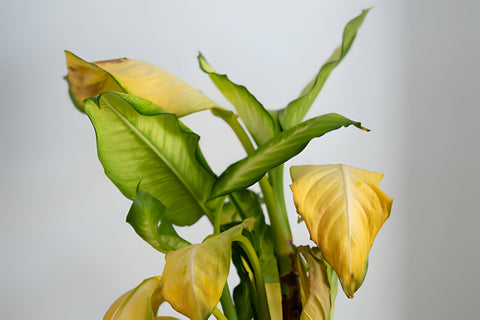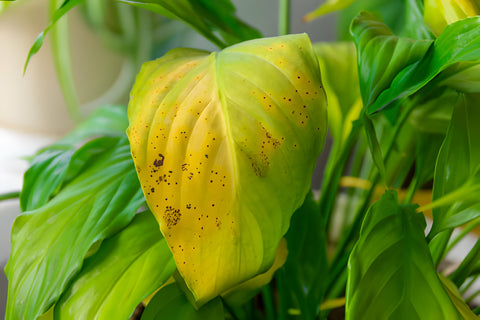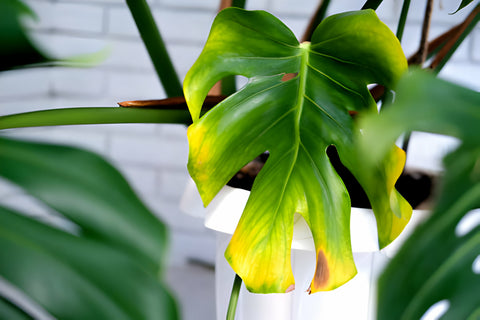Houseplants have become an essential element of contemporary living, seamlessly integrating into our homes and workplaces. These green companions not only enhance the aesthetic appeal of our indoor spaces but also contribute to our well-being by purifying the air and providing a connection to nature. Most houseplants available today have been naturally adapted or selectively bred to thrive in indoor environments, making them relatively low-maintenance and beginner-friendly for plant enthusiasts of all levels.
Starting on the journey of indoor gardening and learning to care for houseplants do require some effort yet yields great rewards. While it may seem daunting at first, understanding the basic needs of your green friends is straightforward. Most issues that arise with houseplant care can be easily addressed with guidance from reliable sources (check out our blogs and YouTube channel for plant care tips, tutorials, and specific guides tailored to various types of houseplants and succulents)
For beginners in the world of indoor gardening, maintaining the lush green vibrancy of houseplant foliage can sometimes be challenging. One common concern is when those once vibrant green leaves begin to turn yellow—a clear signal that your plant is experiencing some underlying issues. This change can stem from a variety of factors and needs to be addressed as soon as possible.
Do Houseplants Shed Yellow Leaves During Seasonal Changes?
Houseplants, unlike outdoor trees, are not as directly affected by the changing seasons, primarily because the controlled environment of a home provides a more stable climate for growth. Outdoor trees experience significant shifts in temperature and light exposure that trigger a distinct response, such as the shedding of leaves in autumn. In contrast, houseplants are sheltered from these drastic changes and typically maintain their foliage year-round.
However, it's not uncommon for some indoor plants to shed older leaves at the end of their growing season (usually during spring and summer). This is a natural part of the plant's life cycle and often doesn't indicate any underlying health issues. When you notice yellowing leaves towards the end of the growing season, you should observe if it's primarily older, lower leaves that are affected while new growth appears healthy. You should also consider whether your plant has recently produced new shoots or blooms, which may explain the shedding of some older foliage.
In essence, while seasonal changes have less impact on houseplants than on outdoor trees, it's normal for some indoor plants to let go of older leaves as part of their growth process. Monitoring your plants for signs of stress beyond this natural shedding can help you provide them with optimal care throughout the year.
When Should You Worry About Yellow Leaves In Houseplants?
Yellow leaves on houseplants can sometimes be dismissed as a natural part of their lifecycle, but there are instances when they serve as a warning signal for potential problems. It's important to recognize when yellowing is part of healthy aging and when it's an indicator of trouble. This article will explore the scenarios that should raise concern among plant owners and provide guidance on how to respond.
- Widespread Yellowing: One of the first red flags is the widespread yellowing of foliage, affecting not just one or two leaves but a significant portion of the plant. This symptom can be particularly alarming if it includes new growth, which should typically be vibrant and green.
- Rapid Leaf Drop: Another cause for concern is when yellow leaves begin to drop rapidly from the plant. A few yellow leaves here and there might not be unusual, but a sudden cascade suggests that the plant is under considerable stress. Rapid leaf loss weakens the plant overall since each leaf represents a source of energy production through photosynthesis.
- Other Symptoms: Problematic yellow leaves rarely occur in isolation when there's a serious problem at hand. They are often accompanied by additional symptoms like wilting despite adequate watering, spots on leaves, stunted growth or deformed new foliage.

Yellow leaves can be a warning signal for potential problems.
Photo by CoinUp
[Common Reasons and Solutions]Common Reasons Why Your Houseplants’ Leaves Turn Yellow
Overwatering
Overwatering is one of the most common reasons for yellowing leaves in houseplants and can lead to a host of health issues if not addressed promptly. When a plant receives more water than it can use, the excess moisture saturates the soil, filling the air pockets and displacing oxygen that roots need to breathe. This anaerobic environment can cause roots to suffocate, weaken, and eventually rot.
Root rot from overwatering typically presents as soft, brown roots that are mushy to the touch, as opposed to healthy white or tan roots that are firm. As the root system deteriorates, it loses its ability to absorb water and nutrients effectively. The first visible symptom above ground is often yellowing leaves—starting with the lower ones—as the plant tries to conserve resources.
The yellowing occurs because chlorophyll (the green pigment) starts breaking down when the plant is under stress. Without sufficient root function, essential nutrients like nitrogen—which is a key component of chlorophyll—cannot be taken up by the plant. This leads to a loss of green color and overall vitality.
Solution:
- Stop watering immediately and allow the soil to dry out.
- Remove any standing water from saucers or decorative pots.
- Put your plant in a bright, airy spot with good airflow.
- If root rot is suspected, remove the plant from its pot and inspect the roots. Trim away any rotten parts with sterilized scissors or pruning shears.
- Repot into fresh soil with proper drainage and consider using a smaller pot if necessary to reduce soil volume that can hold excess moisture.
Underwatering
Underwatering is another prevalent cause of yellow leaves in houseplants, and it occurs when a plant doesn't receive enough water to meet its physiological needs. Plants rely on water not just for hydration but also as a means to transport nutrients from the soil to their cells. When there's insufficient water, this vital process is disrupted, leading to various signs of stress, including yellowing foliage.
The lack of adequate moisture causes the plant's cells to lose turgor pressure—the force that keeps them rigid and upright—resulting in wilting. As the condition persists, the chlorophyll in the leaves begins to degrade, and the leaves turn yellow. This can start at the tips or edges and progress inward as the dehydration worsens.
In addition to yellowing, underwatered plants may exhibit dry, crispy leaf edges, slow growth, dropping leaves, and dry soil pulling away from the pot's edges. The plant conserves its remaining resources by allowing some leaves to die off.
Solutions:
- Gradually increase the amount of water; a severely dried-out plant may not absorb water well initially.
- Soak the pot in a tray of water for a few minutes to rehydrate evenly and help close air gaps in the soil.
- Trim away any severely damaged or dead foliage after rehydrating your plant.
- Monitor your plant closely over the following weeks as it recovers from dehydration stress.

Insufficient watering is one of the reasons of yellow leaves.
Photo by istockphoto
Nutrient Deficiency
Nutrient deficiencies in houseplants can lead to yellowing leaves, a condition known as chlorosis. Each nutrient plays a specific role in plant health, and a lack of these essential elements disrupts normal growth and development. The most common deficiencies that cause yellowing include: nitrogen, iron, magnesium and potassium.
Nitrogen is a key component of chlorophyll, the molecule responsible for photosynthesis and the green color of leaves. A deficiency often results in older leaves turning a pale green or yellow because the plant transfers available nitrogen to new growth. Iron is crucial for the synthesis of chlorophyll, and without it, plants can't produce enough of this green pigment. New growth typically shows signs first, with young leaves appearing yellow while veins remain green. Magnesium is at the heart of the chlorophyll molecule and is also involved in enzyme activation. A shortage may cause older leaves to yellow between the veins—a pattern known as interveinal chlorosis. Potassium regulates various processes including photosynthesis and enzyme activation. When deficient, it can lead to yellowing or browning at leaf edges and tips.
Solutions:
- Assess recent fertilization practices.
- Look for specific patterns of yellowing that may indicate which nutrient is lacking.
- Apply a balanced liquid fertilizer according to package instructions or consider foliar feeding if immediate intervention is needed.
- Test soil pH since extreme pH levels can affect nutrient availability; adjust if necessary.
- Repot to replace the old soil with fresh, nutrient-rich well-draining soil.
Incorrect Lighting
Insufficient or excessive light can both lead to yellowing leaves in houseplants, as light plays a crucial role in photosynthesis and overall plant health. When a houseplant doesn't receive enough light, it may struggle to produce the energy it needs through photosynthesis. As a result, the plant might begin to prioritize which leaves it keeps alive. Typically, older, lower leaves will turn yellow and drop off first because the plant is redirecting its limited resources to new growth that is better positioned to capture light. Symptoms of insufficient light include leggy stems, smaller than usual new leaves, and an overall pale appearance of the foliage. Plants that are variegated may lose their variegation and revert to green.
Conversely, too much direct sunlight can be just as detrimental. Houseplants exposed to overly intense light can experience sunburn, where leaves develop bleached spots or turn yellow due to damage from ultraviolet rays. The affected tissue may eventually become brown and crispy. Signs of excessive light include sudden color changes in the leaves after moving a plant closer to a window or during heatwaves in summer when sunlight is strongest.
Solutions:
- Asset your plant and its placement to decide if it needs more bright light or less direct lighting.
- Relocate your plant to an area with filtered or indirect sunlight, for example, closer to a window or a brighter area, but avoid direct sunlight that could scorch the leaves. Use sheer curtains or blinds to diffuse strong rays during peak hours.
- Rotate your plant regularly for even light distribution.
- If your plant does not have enough light, especially during the dark winter, consider using a grow lamp.
- Don’t forget to gradually acclimate your plants if you're transitioning them outdoors for the summer after a dark winter; or from a gentle to a brighter lighting condition.

Bleached spots is the common signal of sunburn.
Photo by Irina Tiumentseva
Extreme Or Fluctuated Temperatures and Sunburn
Temperature fluctuations, extreme heat or frost, and sunburn are environmental stressors that can cause houseplant leaves to turn yellow. Houseplants typically prefer a stable environment, and sudden temperature changes can be particularly challenging for them to adapt to. Houseplants can become stressed when exposed to rapid shifts in temperature. For example, moving a plant from a cozy indoor setting to an outdoor patio without gradual acclimation can shock the plant. Similarly, placing a plant near a drafty window or an air conditioning vent where temperatures fluctuate widely can lead to yellowing leaves. The stress of adjusting to these changes can disrupt normal cellular functions and photosynthesis, resulting in discolored foliage.
Excessive heat can cause plants to lose water through transpiration faster than they can replenish it, leading to dehydration and yellowing leaves. On the other end of the spectrum, frost can damage plant cells by causing the water inside them to freeze and expand, disrupting cell walls and leading to yellowing or browning of foliage.
Moreover, direct exposure to intense sunlight can scorch houseplant leaves, causing them to turn yellow or develop white, bleached areas that may eventually turn brown and crispy. This is especially true for plants that are not accustomed to direct sun or have been moved suddenly into a brighter location without time to adjust.
Solutions:
- Keep plants away from areas with drafts, such as open windows or doors.
- Avoid placing plants near heating vents or air conditioners.
- Gradually acclimate plants to new environments if you're moving them indoors or outdoors with the changing seasons or from gentle to brighter light.
- During hot weather, ensure your plants receive adequate water and consider providing shade during the hottest parts of the day.
- In anticipation of frost, bring outdoor potted plants indoors or provide protection with frost cloths.
- Use sheer curtains or blinds to filter strong sunlight.
Incorrect Humidity Level
Humidity, or the amount of moisture in the air, is a critical environmental factor for houseplants, and incorrect humidity levels can lead to yellowing leaves. Many houseplants originate from tropical or subtropical environments where humidity is high, and they can struggle in the drier air found in many homes. On the other hand, excessive humidity can also cause problems for houseplants not adapted to such humid conditions.
When the air is too dry (humidity levels of below 40%) plants may begin to lose moisture faster than they can replace it through water uptake from their roots. This can cause leaves to turn yellow and become crispy at the edges as they dehydrate, especially for tropical plants that enjoy humid conditions. Low humidity can be particularly problematic during winter when indoor heating systems are in use, further reducing the moisture content of the air.
Conversely, high humidity levels of above 50-60% can lead to poor transpiration and create an environment conducive to fungal infections like root rot or powdery mildew. These diseases often manifest as yellowing leaves along with other symptoms like soft spots or mold growth. This is especially dangerous for low-humidity plants like succulents and cacti.
Solutions:
- Research your plants to understand their humidity requirements.
- Assess your plants and their growing conditions to decide if they need more or less humidity.
- To increase humidity around your plants:
- Group plants together to create a microclimate with higher humidity.
- Place a tray of water near your plants; as it evaporates, it will add moisture to the air.
- Use a humidifier in rooms where you keep your plants.
- Regularly mist your plants with water, though this provides only temporary relief.
- To reduce humidity:
- Improve air circulation around your plants by using fans or opening windows.
- Avoid overcrowding plants which can trap moist air around foliage.
- Be cautious with watering; allow soil to dry out appropriately between waterings.

Humidity level also makes the leaves turn yellow.
Photo by Ashley-Belle Burns
Pests and Disease
Pests and diseases are significant factors that can lead to the yellowing of houseplant leaves. When plants become infested with pests or succumb to disease, their ability to function normally is compromised, often resulting in discolored foliage.
Common houseplant pests such as aphids, spider mites, scale insects, and mealybugs feed on plant sap by piercing the leaves and stems. This feeding action not only weakens the plant but can also introduce toxins or cause physical damage to the tissue, leading to yellowing leaves. Pests may also produce honeydew, a sticky substance that encourages sooty mold growth and further reduces a plant's ability to photosynthesize.
Fungal and bacterial diseases can also cause yellowing leaves in houseplants. Overwatering often leads to root rot diseases where roots become mushy and brown, losing their ability to absorb water and nutrients effectively. As a result, leaves turn yellow due to starvation and stress. Other diseases like powdery mildew or leaf spot may directly affect foliage, causing distinct patterns of discoloration.
Solutions:
- To treat pest infestations:
- Inspect new plants thoroughly before introducing them to your home.
- Isolate affected plants to prevent the spread of pests.
- Remove visible pests by wiping leaves with a damp cloth or using a gentle stream of water.
- Treat infested plants with insecticidal soap, neem oil, or other appropriate treatments according to the specific pest problem.
- To treat plant diseases:
- Remove any diseased leaves promptly and dispose of them properly.
- Repot if needed.
- Provide bright air and good air circulation around your plants to boost photosynthesis and promote healing.
- Ensure proper watering practices—allow soil to dry between waterings.
- Avoid wetting foliage when watering as damp leaves can be more susceptible to fungal infections.






























